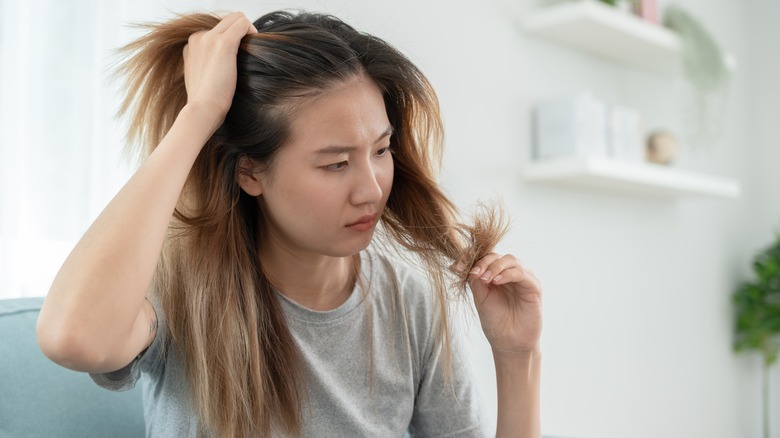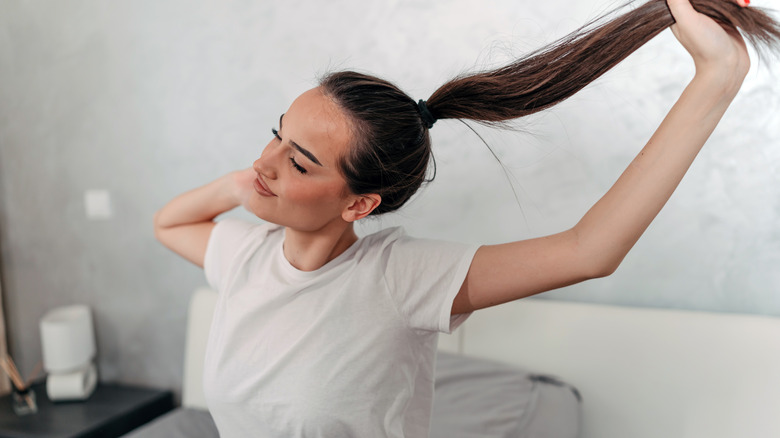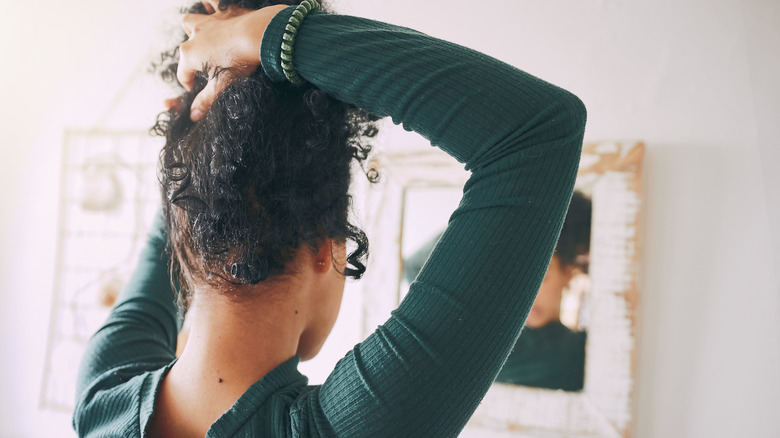This Common Hair Mistake Is Secretly Aging You
Our hair is usually a powerful indicator of aging. No matter what color your locks are and where in the world you're from, the signs of aging are universal. Graying and dryer strands and dull or brittle locks are all part and parcel of it; although some people decide to dye their hair instead of letting it gray.
And while we might not be able to prevent all of the things that happen to our hair as we age, there are some things we can do, like how we choose to style our tresses. While a ponytail might have been your go-to style in high school and university, it's a hairstyling mistake that's secretly aging you; not to mention potentially causing headaches (via Healthline). And it has to do with just how much stress you're putting on your hair strands with this hairdo.
Tightly pulling your hair back all the time can lead to something called traction alopecia, as New York City-based dermatologist Francesca J. Fusco explained to Allure. Have you ever noticed those smartly dressed characters in those detective series on Netflix (or even real-life friends or family members) who consistently wear their hair in high ponytails and seem to have short and fuzzy hair strands on their hairline when you look closer? This is because the constant tugging has caused breakage and left a receding hairline in its place. The effects of traction alopecia can be permanent, especially if you damage your hair follicles, per the American Academy of Dermatology Association.
It's not just your hairline that ponytails hurt
If you thought the hair loss was only going to be in your hairline, you are sorely mistaken. Wearing a tight elastic band around the same area of your locks for years can stress and damage the hair in that specific spot and lead to hair thinning, Jenna Marie Shafer, New York City-based session hairstylist, told Byrdie.
"When you wear your hair in the same ponytail every day, you're adding stress to the same spot over and over and over again, and eventually that's going to cause your hair to snap and break off at the base of the ponytail," Shafer shared. Remember how we said thinning hair is part of the signs of aging anyway? It seems wearing your hair in a ponytail every day could be accelerating this process.
We get it. Ponytails are a no-fuss and efficient hairstyle, which is why they are so common. Have a workout to get to? Just grab all your locks and pull them away from your face in a ponytail. Late for an important meeting and you didn't have time to wash your hair this week? Just put your locks in a ponytail and you're good to go. But any hairstyle that tugs at your hair all the time, like ponytails (think tight buns, tight braids, cornrows, etc.) is damaging your hair and secretly aging you in the process. However, there are ways you can style your hair to avoid aging yourself.
Does this mean ponytails are a complete no?
Not necessarily. Experts recommend not turning to ponytails frequently, so this means you might be able to get away with that occasional classy high-ponytail look for a professional work meet-up or a hot date.
But on the days when you don't have to resort to this hairstyle, consider loosening up those strands instead. Opt for a lower, looser braid which can look just as professional. Do you work out often? Consider a loose top knot instead of a tight pulled-back braid that adds stress to your hairline. If you have to go with a ponytail, avoid elastic ties that cause breakage and opt for more hair-friendly tools like ribbon hair ties or scrunchies. And whatever you do, don't sleep in tight ponytails at night.
When you're pulling your hair back, don't make the common mistake of brushing your hair totally wrong either, added hair and makeup artist, Vibha Gusain (via Vogue India). "Brush your hair from the bottom first and not the top, as when you brush from the top, you get a lot of tangles. It's better to start from the bottom so that you pull less," she explained. Ultimately, it's important to remember that it's not only about the shampoos, conditioners, and hair serums you use or the foods you eat or avoid for healthy hair. Something as simple as how you style it can impact not only how it looks but also how soon you start looking older.



